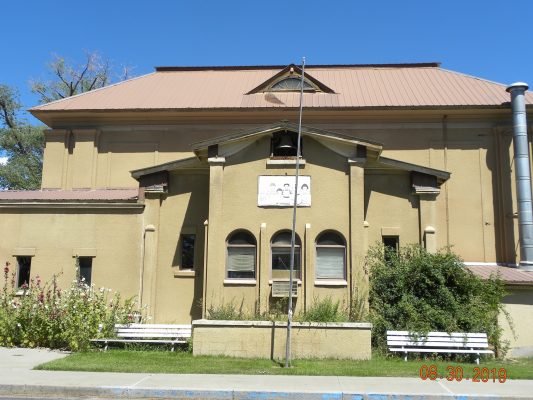
The main school building at the Southern Ute Boarding School Campus, constructed in 1901.
Year Listed: 2020
County: La Plata; Southern Ute Reservation
Construction Date: 1901; 1920-56
Threat When Listed: Demolition and neglect
Status: IN PROGRESS
The Southern Ute Boarding School Campus (SUBSC) reflects a difficult and multi-faceted story of the Indian Boarding School Era within Colorado and American history. The federal government’s efforts to control, contain, and civilize the oldest, longest continuous inhabitants of Colorado began pre-statehood, after the Mexican-American War, with the signing of the Treaty of Abiquiu in 1849. Fighting against all odds of cultural-genocide via forced assimilation, the SUBSC also represents the resilience of Southern Ute foremothers and forefathers, descendant from the Mouache, Capota, and Weeminuche Bands of Ute, others from various Indigenous Nations—i.e. Jicarilla, Apache, and Navajo. The Treaty of 1868 designated the western third of Colorado as the first Ute Reservation and illustrates the earliest mention of the United States’ ruthless agenda to eradicate Ute heritage through a military-based model of American education. The military-based model of Americanization pioneered by Capt. Richard Pratt, at Carlisle Indian Industrial School in Pennsylvania, was the method the United States Government intended to implement for the Southern Ute. Article 8 of the Treaty of 1868 expresses the United States government’s intent “… to ensure the civilization of the bands entering into this treaty” and train the Southern Utes to become laborers and agriculturalists.

The Girl’s Dormitory at the Southern Ute Boarding School Campus
The initial building of the SUBSC was constructed in 1901, after several unsuccessful education programs at Ute agencies between 1868 and 1877. In 1920, the SUBS closed and between then and 1956 the school underwent several developments over time that reflected changing educational, tribal, and governmental and community uses. At various times in its 79-year history, the campus housed and or educated Ute and other Indigenous students. Over the years, the SUBSC included a hospital, girl’s dormitory, dining hall, classroom buildings, a vocational school, dairy barn, and silo before closure in 1981. Today, the Main School House, Dining Hall, Girl’s Dormitory, Nurses Quarters, and the Park with the Center Flag Pole are all that remain from this controversial era. The structures are a reminder of the past that Native Americans were subjected to, but also serve as a reminder of resiliency. It is symbolic of a rich culture that the government ruthlessly tried to eradicate, attempts that were unsuccessful. It is the proof of an era in American history that was purposefully hidden and still withheld from textbooks.
CPI held an initial site orientation with the Southern Ute Tribal Council and shared examples of successful school rehabilitation projects from across Colorado. After receiving positive feedback from tribal members, the tribal council has carried out environmental assessments in the Head Start School Building, Gymnasium, and Dining Hall. In addition, May & Burch Conservation Inc. studied culturally significant WPA-era murals, completed by tribal member Sam Ray, in these buildings in order to provide options for future preservation efforts. CPI highlighted the campus as one of five key EPP sites in 2022 and will continue to work with the Southern Ute Tribe to support the rehabilitation and preservation of these important resources.



